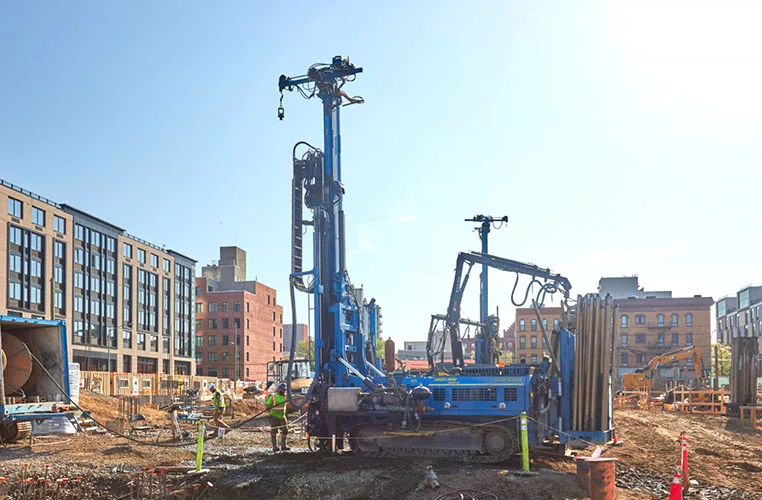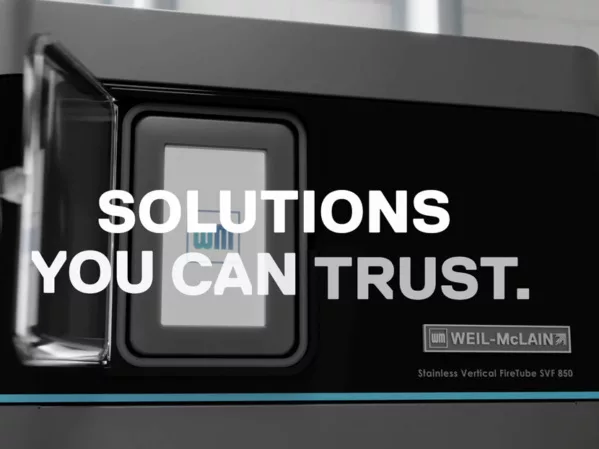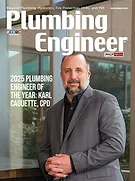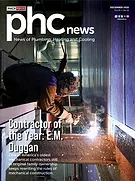While New York City, especially Manhattan, is known for thousand-foot skyscrapers, its newest feat occurred nearly 500 feet underground in the Borough of Brooklyn. The 1 Java Street project, developed by Lendlease, is being built at the East River waterfront just north of the Williamsburg Bridge. It is the largest mixed-use development in New York state to include a ground-source geothermal system for heating and cooling.
When completed in 2026, there will be more than 800 residential apartments plus retail spaces in two towers, and three other buildings, which are all connected. The complex will be fully electric, using no natural gas or fuel oil.
The developer’s goal is to achieve absolute zero carbon across scopes 1, 2 and 3 by 2040, be LEED Gold plus WEDG Waterfront Certified, and ensure that the project will meet or exceed Local Laws 97 and 154, both of which are part of New York City’s decarbonization legislation.
The geothermal system included 321 vertical boreholes drilled 499 feet into the ground, spaced on 15-foot centers with a 1 1/4 inch diameter high-density polyethylene (HDPE) PE4710 DR11 pipe loop inserted into each. The boreholes were just 3.875 inches in diameter. A total of 326,000 feet was used in the boreholes with another 31,000 feet of HDPE pipe in various diameters used for lateral distribution.
The 499-foot depth — not even 500 feet — was required due to New York state regulations. Drilling 500 feet or deeper requires a mining permit, adding to the cost of a project. The state has since exempted deep boreholes for geothermal projects.
The boreholes were drilled by Geosource Energy (Ancaster, Ontario), which also installed geothermal pipe loops as ground heat exchangers. The Ontario-based company was brought in to solve the problem of drilling in rock under 90 feet of overburden, with the top 50 feet being soft fill and muck, then 40 feet or more of solid silt. Brightcore Energy (Armonk, New York) oversaw the geothermal installation.
“We were running dual rotary Novamac Geo-Max rigs,” explains Stanley Reitsma, P.Eng, Ph.D., CEO of Geosource. “So, getting to the rock at a hundred feet was no problem because of those machines. Then, drilling the rock was a success because we had multiple techniques at our disposal. This was heavily fractured with an awful lot of water production and couldn’t be done drilling with air, which would be typical.
“We had already tested, done an awful lot of water drilling during our 20 plus years in business, which is what we did there. And we managed to get that first hole in and knew we were good. We knew we would be good for the rest of the holes and started drilling, picking away at the beginning with one rig, and eventually got elbow room to do two, then three and then four rigs.”
The crew was working in the middle of all the other construction.
“Pilings, the beginnings of elevator shafts — it was all going in there,” Reitsma continues. “A very congested site and that was challenging, especially if you were running truck (drilling) rigs in there, for example, which many U.S. operators do. It’s mostly Canadians on tracks because we’ve been at it a little longer, with most of our projects being urban construction. This forced us to adopt track machines for those types of applications.”
He adds: “Our geothermal crew had to be able to spin around on a dime to go one way and then turn the other way, creep up right against the side of a pile cap — those kind of situations. It was really tight. So that was very difficult.”
With 321 holes on 15-foot centers, it was 225 square feet per hole, totaling 72,000 square feet — about 1.7 acres, Reitsma says. “We were in there with four rigs knocking out 20 holes a week with a crew of 12. On this site, every available area that could be drilled was drilled. Then we looped all the holes and routed them back with a bentonite graphite mix, a very standard product for running geothermal. And all the loops were pressure-tested.”

Geothermal continues its popularity
The 1 Java Street job was voted the 2023 Project of the Year by the Building & Construction Division (www.plasticpipe.org/buildingconstruction) of the Plastics Pipe Institute (PPI) for its use of HDPE pipe to achieve a sustainable heating/cooling system. Each year, the PPI membership reviews and votes on the Project of the Year for each of the five PPI divisions. The award was presented to PPI member company Versaprofiles Products (Saint-Lazare-de-Bellechasse, Quebec), the pipe manufacturer, during the association’s annual membership meeting held in May 2024.
“According to the U.S. Department of Energy, ground-source heat pump systems use 25 to 50% less electricity than conventional heating and cooling systems,” says Lance MacNevin, P. Eng., director of engineering for PPI’s Building & Construction Division. “This means that geothermal heat pumps are economical to operate and can significantly reduce operating costs during the life of the system.
“Geothermal systems also operate with fewer emissions than fossil-fuel-burning appliances, reducing carbon dioxide emissions. These systems use long-lasting plastic piping materials as ground heat exchangers, another example of how plastic piping is helping the environment. The popularity of geothermal systems continues to grow so much that we even have a committee devoted to it.”
The division’s Geothermal Steering Committee focuses on the geothermal industry with activities that include supporting industry efforts to update geothermal standards and codes, such as CSA/ANSI/IGSHPA C448, Design and installation of ground source heat pump systems for commercial and residential buildings; the Uniform Mechanical Code and Uniform Solar, Hydronics and Geothermal Code from the International Association of Plumbing and Mechanical Officials; and the International Mechanical Code and International Residential Code from the International Code Council.
It also works closely with the International Ground Source Heat Pump Association (IGSHPA), GEO and other related organizations; publishes documents about the use of plastic piping systems for geothermal applications; and serves as a technical resource for geothermal system designers, with regard to plastic piping technologies.
To provide guidance in selecting the proper materials and installation, the group has recently updated its technical document, PPI TN-55 “Plastic Piping Materials for Ground Source Geothermal Heating and Cooling Applications.”
The new technical note describes eight installation techniques, such as vertical boreholes, inclined or angled configurations, horizontal directional drilling and energy piles. It discusses design topics, such as the effects of borehole depth on static water column pressure, and addresses why oxygen diffusion barrier layers are typically not required for ground heat exchanger piping.
According to NY GEO, the not-for-profit founded in 2014, “GHP systems work to improve utility load factors while reducing peak demand.”
The geothermal loops consist of two strands of pipe (one up, one down) united at the bottom of the hole by a fused U-bend fitting. Those loops of PE4710 DR11, 1 1/4 inch diameter pipe, or U-bend assemblies, named Verticaloop, are made at the Versaprofiles factory, fused and pressurized to the exact length required by the project. The sections of the 31,000 feet of lateral distribution pipe are 40 feet long and also made with PE4710 HDPE resin.
“We end up with factory-fused pipe loops done in a clean environment and pre-cut to length,” Reitsma says. “If you push it in the hole and there’s still a whole bunch left over, you know you haven’t hit the bottom. It’s another way to double-check your depth.

“The PE4710 is great pipe. It’s a longer-lasting pipe with less chance of fatigue. You’re never getting back under a building like 1 Java, so we need stuff that’ll last as long as the building. And we think PE4710 should last a hundred years plus.”
Reitsma, who has more than 20 years of geothermal planning and drilling experience, shared advice for geothermal project managers and designers.
“Because we’re the deepest, we should go in first,” he explains. “That is how we do 99% of the jobs happening in Toronto. We haven’t seen that yet in New York, for example; it hasn’t caught onto that concept because it’s unfamiliar. It’s the sequence of the work: allow the geothermal to go in, and then the piles and foundations. By the time the site is ready for that, we should be well done and out of the way.”
Steve Cooper has reported on a variety of plumbing, construction and infrastructure projects for several decades. Based in New York, he has traveled extensively to conduct on-site news interviews with professional engineers, contractors, government officials and representatives of major companies supplying the industry. He can be reached at 516-623-7615 or [email protected].




